“Oh no, I will be having tea with a friend tonight.”
It was nearing Midwinter, and the elderly tiefling refused every offer of hospitality she was offered. She had no home, and lived beneath bridges or in the corners of generous taverns. Superstitious folk in her little village thought she was odd, and avoided her, but most saw her as the village grandmother, and did their best to help her. A scarf in the winter, a roof in the rainy season, a waterskin in summer’s heat. But there were nights when she turned away all charity.
The tiefling with a face wrinkled like wet cloth sat atop a hill beneath the stars on Midwinter’s night, with the distant lights of the village twinkling far below her, and the lights of the night stars shining above. Cold winter air whipped around her, carrying tiny flurries of snow on its gusts. She seemed unbothered by the elements, but warmed her hands against a delicate teacup that billowed steam into star-speckled sky. She squinted her rheumy eyes and peered into the sky. She raised one clawed finger to point at a star in the sky; one she had reached out to touch hundreds—thousands—of times before.
It seemed to shine brighter.
Her finger drew a line from that star to another one nearby. Then another, and another, until she had traced out a complete constellation. She breathed a sigh, exhaling a cloud of mist that mingled and swirled about the steam from her teacup, and she settled on her creaky bones onto the frost-covered grass beneath her. She stayed still, and sipped her tea. The timing of this ritual had been burned into her mind by years of repetition, so she waited, and the stars shone brighter.
The tiefling blew once on her tea, and a little cloud of steam rolled off of its black, unsweetened surface. She blew again, and again, until a swirling mass of sparkling silver steam curled and danced in front of her. The cloud seemed to form the shape of a person, and the stars that blazed behind it seemed to take the shape of its eyes, its spine, its arms, and its legs, until a woman with bones and eyes of starlight and a body of mist stood with arms outstretched. The tiefling—the warlock—smiled and stood to embrace her patron and her beloved.
“What did you tell them?” the starlight woman asked, a smile in her ethereal voice.
The warlock gazed up and smiled. Magic blazed in her eyes and crackled in the air around her being. “Nothing untrue. Just that I will be having tea with a friend.”
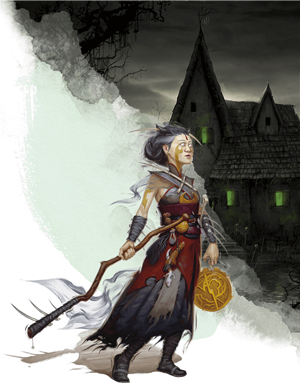 You are a warlock. You are a conduit for the power of a being of god-like power. You may use this incredible gift for good or for evil. You may use it for your own purposes, or you may live to serve your supernatural patron’s inscrutable ends—or darker still, you may think you are pursuing your own agenda, when in reality you are naught but a puppet dancing on eldritch strings. Your pact may be with a Fiend, such as the archdevil Asmodeus or the demon lord Orcus, an Archfey, such as King Oberon or the mysterious Queen of Air and Darkness, or a Great Old One, like slumbering Cthulhu or Tharizdun the Chained God. Other warlock patrons exist, shrouded by time and space. In Critical Role, Matthew Mercer presents a brand-new patron: the god-spawn Uk’otoa; consider working with your DM to create the ideal patron for your warlock!
You are a warlock. You are a conduit for the power of a being of god-like power. You may use this incredible gift for good or for evil. You may use it for your own purposes, or you may live to serve your supernatural patron’s inscrutable ends—or darker still, you may think you are pursuing your own agenda, when in reality you are naught but a puppet dancing on eldritch strings. Your pact may be with a Fiend, such as the archdevil Asmodeus or the demon lord Orcus, an Archfey, such as King Oberon or the mysterious Queen of Air and Darkness, or a Great Old One, like slumbering Cthulhu or Tharizdun the Chained God. Other warlock patrons exist, shrouded by time and space. In Critical Role, Matthew Mercer presents a brand-new patron: the god-spawn Uk’otoa; consider working with your DM to create the ideal patron for your warlock!
Warlocks are a spellcasting class, like a wizard or cleric, but they follow completely different rules. While other casters have the Spellcasting feature, warlocks instead possess the gift of Pact Magic. This means that you have precious few spell slots, but your spells are always cast at the highest possible level, and you regain your spell slots on a short rest instead of a long rest. As long as you have time between encounters to reach out and borrow more of your patron’s power, you can continue slinging spells all day. And that’s to say nothing of your cantrips; you possess easily the most powerful damaging cantrip in the game: eldritch blast.
Because of their unusual spellcasting style, warlocks have a lot of moving parts. They’re one of D&D’s most complex classes, so you should have a firm understanding of the general rules of D&D and the rules of spellcasting before you play a warlock. Warlocks are also an excellent choice of class if you want to roleplay, but aren’t sure where to start. Because of their supernatural pact, the warlock class automatically gives you roleplaying opportunities. Read Erin M. Evans’ Forgotten Realms novel Brimstone Angels for an excellent example of the tiefling warlock Farideh developing a relationship with her patron, the cambion Lorcan.
If the aforementioned appeals to you… then let’s make a pact. The most important thing about playing a character in Dungeons & Dragons is playing them in a way that’s fun for you and your fellow players. However, there are certain basics of how to effectively play a warlock that every player should know. D&D is a party-based game in which several characters with a diverse array of abilities contribute to their team’s success in different ways. You should know how to fill your role in the party effectively so that you can help your team advance through the campaign’s story as well as develop your own personal story. This guide will cover the basics of eldritch magic, walking you through the first 5 levels of playing a warlock.
Quick Build Expanded: Building Your Warlock
This isn’t a character optimization guide, but the first step in playing your class effectively is building it effectively. The Quick Start guidelines in the Player’s Handbook are a good start, but don’t go far enough for most new players. Here’s an expanded Quick Start guide. This guide assumes you’re using the D&D Beyond Character Builder, which includes helper text for new players.
- Under “Character Preferences,” turn off “Playtest Content” and “Show Unarmed Strike”
- Choose your Race. While any race can be a good warlock, the most powerful warlocks tend to be from races that improve your Charisma score. Charisma is your most important ability score because it determines the power of your spells and class features.
- Tieflings are excellent warlocks because of their innate +2 bonus to Charisma and their access to racial spells, which help ballast their limited spell slots. Tieflings are, in many ways, the stereotypical warlock. You’ll definitely be playing into type by choosing this race, but you can still break the mold by making a pact with an unusual patron, such as an Archfey or the Undying.
- On the opposite side of the coin, the divine-descendant aasimar (from Volo’s Guide to Monsters) also have a natural +2 to Charisma, and are a thematic choice for making a pact with a Celestial (from Xanathar’s Guide to Everything). A fallen aasimar making a pact with a Fiend or an Old One would be a delightfully off-color choice, too.
- Yuan-ti purebloods (also from Volo’s Guide to Monsters) gain a +2 bonus to Charisma, and have a strong lore connection to Dendar the Night Serpent, an Elder Evil that could easily be considered a Great Old One.
- Half-elves have a +2 Charisma bonus, and there are compelling reasons for a half-elf that has been ostracized from human or elven society to seek the power of an otherworldly patron.
- Humans are an attractive pairing with just about any class, and their broad array of ability score bonuses are appealing to warlocks who want to fight in close quarters, like those who form the Pact of the Blade, especially with a Hexblade patron.
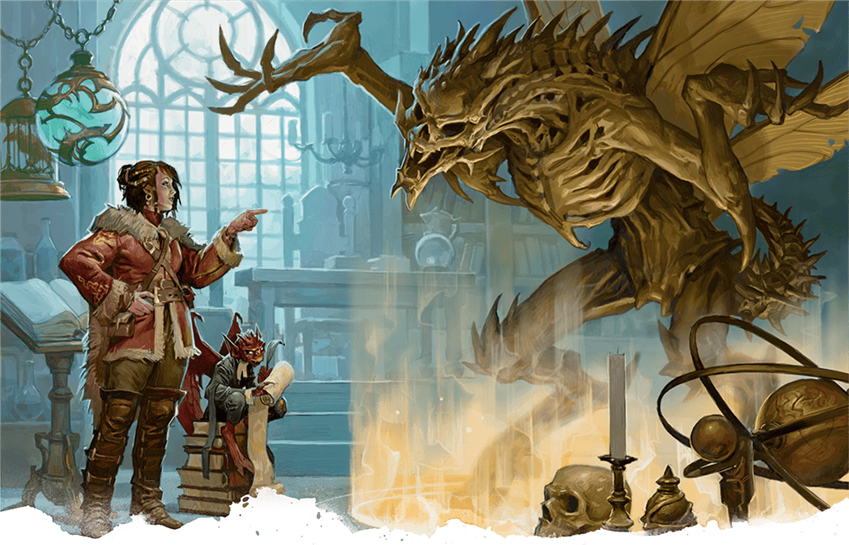
What Kind of Warlock Are You?
Warlock is one of the most complex and customizable classes in D&D. While superficially similar to other spellcasters like sorcerers and bards, warlocks have a completely different method of casting spells, and also have unique choices in the form of Eldritch Invocations. Because of this innate customizability, the warlock is a highly flexible class that can take on just about any role in an adventuring party, depending on their choice of patron, pact, and invocations. Your first role-defining choice is your Otherworldly Patron (hereafter referred to as a subclass); this decision will start to carve out a thematic and mechanical niche for your character.
You could specialize in Offense by choosing spells and invocations that empower your damage-dealing spells, and relying upon your allies to protect you when you run out of juice. You could also choose to take on a Defense role, hampering enemies with control spells and keeping yourself safe with warding magic. The role of Tank is an odd one for a spellcasting class, but you can make decisions that will make you a warrior formidable enough to draw fire from your more vulnerable allies. Finally, Support is also an unusual role for a warlock, but you can choose a patron and spells that allow you to buff and heal your allies instead of raining woe upon your enemies.
Since you choose your subclass at 1st level, you don’t have any time to get a feel for your character and how you want to play them before you choose your subclass. Fortunately for you, your choice of subclass is deeply entwined with your character’s roleplaying concept. This should help make choosing a patron a less daunting task.
(And note, I’m using Offense, Defense, Tank, and Support as shorthand. No part of D&D refers to characters in this way, but it’s an easy way to discuss the different roles characters serve in the party.)
Offense
Offensive warlocks channel all of their power into destructive spells and deadly weapons, leaving little consideration for their own safety. Warlocks who make a pact with the Fiend gain spells that reinforce this archetype, as well as the powerful Hurl through Hell capstone at 14th level. Warlocks who make pacts with the Celestial (Xanathar’s Guide to Everything) have miraculous healing powers, but they also gain access to spells that call down the wrath of the heavens. Finally, warlocks who bond with the Hexblade (Xanathar’s Guide to Everything) prefer to don armor and take to the front lines, armed with their supernatural blade.
Defense
Warlocks who specialize in Defense prefer to ward themselves from harm while controlling the battlefield with spells that manipulate the elements, create illusions, or rend space itself. As such, warlocks who borrow power from the Great Old One make outstanding defensive spellcasters, and those who serve an Undying patron (Sword Coast Adventurer’s Guide) have an uncanny knack for surviving even the deadliest circumstances. Warlocks who serve the Archfey possess powers that beguile enemy combatants, leaving them vulnerable to your allies’ attacks—all while staying perfectly safe under a shroud of invisibility.
Tank
A Tank stands up to mighty enemies and uses their own threatening demeanor to draw attention away from their more vulnerable allies. Such warriors tend to wear thick armor and boast mighty defensive capabilities—both traits that few warlocks possess. Only warlocks blessed with the power of the Hexblade possess the ability to wear medium armor and shields, and their fearsome one-on-one combat abilities make them high-value targets on the battlefield.
Support
Warlocks blessed by a pact with a Celestial possess magic similar to that of a cleric, granting them formidable healing and restorative abilities. They also possess unique powers that can call down retributive wrath upon enemies who would dare attack them, making them a less appealing target in combat, despite their low defenses.
Quick Build Expanded (Part 2)
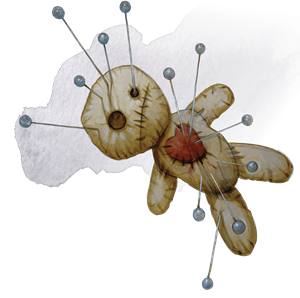
- Place your highest ability score in Charisma. The best place to put your second highest ability score depends on what role you want to fill in your party, but you can just as easily place it wherever you want.
- If you want to fill the role of Offense in your party and focus on dealing damage, place your second highest ability score in Dexterity. (If you want to play a Hexblade, put it in Constitution instead; those extra hit points will come in handy.)
- If you want to fill the roles of Defense or Tank in your party and focus on survival, place your second highest ability score in Constitution.
- If you want to Support your party, put your second highest ability score in Dexterity, which will help shore up your low Armor Class.
- Choose any background that fits your character concept. This is your chance to create a backstory that defies convention, or that plays it straight. Was your warlock an acolyte of a dark cult, indoctrinated since birth? Were they a hermit that saw beyond the stars in your solitude? Or were you a street urchin that traded the only commodity you had—your soul—for the chance to escape poverty and get revenge on those who scorned you?
- Finally, determine your equipment. For an easy selection, click on “EQUIPMENT” when promoted to “Choose EQUIPMENT or GOLD”.
- Given the choice between a simple weapon and a light crossbow, choose a simple weapon that fits your vision of your character. You’ll always have eldritch blast for ranged combat.
- There’s no mechanical difference between a spell component pouch and an arcane focus, so choose whichever fits the look of your character.
- Choose a scholar’s pack if you plan on spending a lot of time in civilization, or an explorer’s pack if you won’t.
- Pick another simple weapon!
- If you chose the Hexblade patron, you should choose “GOLD” instead, and purchase your starting equipment a la carte. You’ll start with an average of 50 gold, so choose a set of hide armor, a shield, a martial weapon of your choice, and spend the rest of your money on adventuring equipment. If you got lucky rolls and got at least 70 gold to start, buy a chain shirt instead of hide armor.
A Warlock in Combat
Combat is a careful balancing act for you. You only have one spell slot at 1st level, so you need to use it at the proper moment. If you plan on casting a spell like hex, that moment could be as soon as possible, and then you fall back on your plentiful cantrips to deal damage. Even as you level up, you need to conserve your resources; you gain a second spell slot at 2nd level, but you don’t gain a third until 11th level!
Just like sorcerers and bards, you learn new spells as you level up, and can cast any of your spells known with your limited spell slots. This differentiates you from spellcasting classes like wizards and druids, who have access to a wide array of spells, but must prepare a small selection of them whenever they complete a long rest. You also have access to a wide selection of cantrips—especially if you forge a Pact of the Tome at 3rd level—that you can cast at-will without expending spell slots. Use these like a fighter would use a sword or crossbow, and save those powerful leveled spells to make them really count!
Warlocks have dozens of discrete decision points between their choices of Otherworldly Patron, Pact Boon, and Eldritch Invocations, but the most granular of these choices are a warlock’s spell selection. To alleviate some of the anxiety of choosing spells, a selection of sample spell lists and invocations have been provided below. These sample lists are based on your preferred role in the party, and can easily be changed to fit your personal vision for your character. If you find that a spell isn’t working for you, you can exchange one spell for another whenever you gain a level in this class. But you can only exchange one spell per level up, so don’t think you can swap out your entire spell list whenever you gain a level. You can (and should) tailor these lists of spells to not just your personal preference, but also to the sort of challenges you are facing in your own campaign.
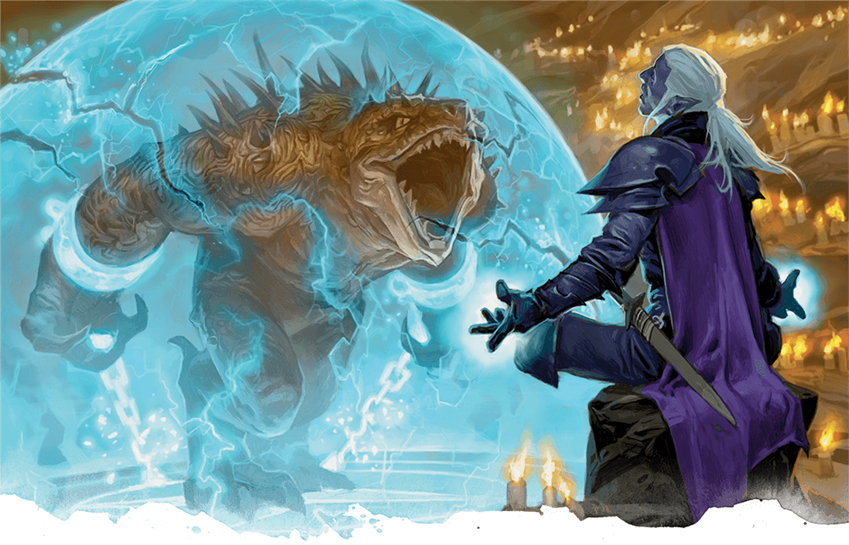
All Warlocks
At 1st level, you forge a pact with an Otherworldly Patron. This choice will help determine your role and grant you additional powers throughout the campaign.
At 2nd level, you can amplify your arcane power with Eldritch Invocations. These invocations support your role in the party, and are discussed below. You also gain your second spell slot, marking a massive increase in your flexibility.
At 3rd level, you refine the pact you sealed with your patron by choosing a Pact Boon, selecting from Pact of the Blade, Pact of the Chain, or Pact of the Tome. Which boon you should choose is largely dependent on your party role, and is discussed below.
At 4th level, you gain an Ability Score Improvement or a feat! Most warlocks want to maximize their Charisma score as quickly as possible to increase their spells’ potency, but you may wish to choose a feat to accentuate your role in the party.
At 5th level, you gain access to 3rd-level spells. This marks a huge increase in potential power, and the spells you’ll want to choose are role-specific.
Offense
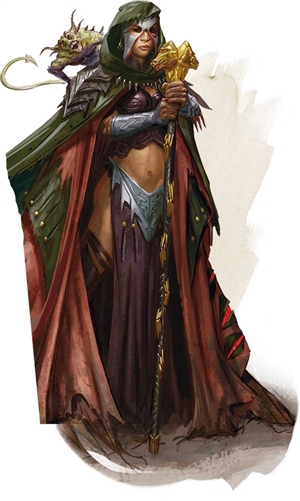 Warlocks may have limited spell slots, but they possess invocations that empower their cantrips to ludicrous strength, and automatically cast their spells at the highest available power level. This is always useful to warlocks who specialize in destructive magic. Warlocks who make a pact with the Fiend or the Hexblade are best suited to Offense. Celestial warlocks also have potent offensive capabilities. Your choice of patron grants you additional spells, many of which are crucial to your offensive capabilities.
Warlocks may have limited spell slots, but they possess invocations that empower their cantrips to ludicrous strength, and automatically cast their spells at the highest available power level. This is always useful to warlocks who specialize in destructive magic. Warlocks who make a pact with the Fiend or the Hexblade are best suited to Offense. Celestial warlocks also have potent offensive capabilities. Your choice of patron grants you additional spells, many of which are crucial to your offensive capabilities.
At 1st level, you learn two cantrips from the warlock spell list. You don’t get to change these, so choose wisely. You should choose at least two offensive cantrips so that you always have an at-will attack to fall back on. Eldritch blast is a must-have for any warlock, and green-flame blade is a good pick for a melee-focused warlock. Otherwise, consider a more close-range spell, like poison spray or thunderclap.
Also at 1st level, you learn two 1st-level spells from the warlock spell list. Hex is a must-have spell, thanks to its long duration. Note that you can change the target of your hex at any time after its current target has died, so long as you maintain concentration. This means that your hex can last between combat encounters, especially when cast at higher levels. Armor of Agathys is a strong choice, as it grants you increased survivability and additional damage; it also scales well with level.
At 2nd level, you learn a new 1st-level spell. Hellish rebuke is a solid choice, as it allows you to continue dealing damage even when you’re on the defensive. You also get to choose two Eldritch Invocations. Agonizing Blast is a must-have, as it increases your damage output severely. Your other Invocation should be a social invocation, such as Mask of Many Faces, or an exploratory one like Devil’s Sight, in order to round out your skill set.
At 3rd level, you gain the ability to learn 2nd-level spells from the warlock spell list. Also, all of your spell slots become 2nd-level spell slots. If a spell gains power from being cast in a higher-level slot, it will have a section at the end that says “At Higher Levels”. You learn one new spell, like shatter or shadow blade.
You also gain a Pact Boon. Pact of the Blade is excellent for Hexblade warlocks or any warlock that wants to fight in close quarters. Pact of the Tome serves warlocks that prefer to fight from afar; it grants you three cantrips from any spell list. Pact of the Chain grants you a powerful familiar, which you can use to help you explore dangerous areas, and even aid in combat! All of these boons are useful to the Offense role in different ways, especially since they unlock specific Eldritch Invocations later on, but Pact of the Blade is the most purely offensive in nature.
Since you can choose one of the invocations you know and replace it with another available invocation whenever you level up, you can gain access to boon-specific invocations at this level, like Aspect of the Moon, Book of Ancient Secrets, Gift of the Ever-Living Ones, Improved Pact Weapon, or Voice of the Chain Master.
At 4th level, you gain an Ability Score Increase, or a feat! If you want to improve your chances of dealing greater damage, you should put both points into Charisma. If you want a feat to help improve your damage output, consider the Lucky, Spell Sniper, or War Caster feats. A Dexterity-focused Hexblade might also like the Medium Armor Master feat.
Also at 4th level, you gain an additional spell. Consider taking a spell that improves your stealth or maneuverability, like invisibility, or an offensive spell with additional effects, like mind spike. You also learn an additional cantrip from the warlock spell list. A non-combat focused cantrip will make you a more versatile adventurer.
At 5th level, you gain the ability to learn 3rd-level spells from the warlock spell list. Also, all of your spell slots become 3rd-level spell slots. Fly is an incredibly powerful spell in the hands of an offensive caster, but warlocks who wish to stay grounded may find vampiric touch to be an attractive option.
Also at 5th level, you gain an additional Eldritch Invocation. If you chose the Pact of the Blade boon, Thirsting Blade is almost always your best choice. Maddening Hex is also an attractive choice, and One with Shadows makes it a snap to get the jump on unsuspecting foes.
Defense
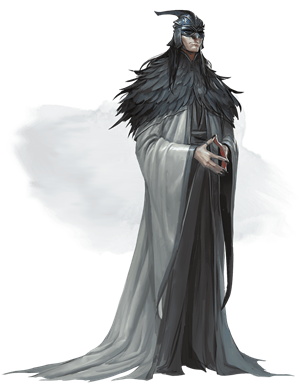 Playing Defense isn’t just a matter of staying alive; it’s about making life frustrating for your enemies. Spells that disturb the battlefield or mire your foes’ minds are just as much a boon to you as spells which directly increase your own armor or hit points. Warlocks who make a pact with the Great Old One, the Undying, or the Archfey are best suited to Defense. Your choice of patron grants you additional spells, many of which are crucial to your defensive capabilities.
Playing Defense isn’t just a matter of staying alive; it’s about making life frustrating for your enemies. Spells that disturb the battlefield or mire your foes’ minds are just as much a boon to you as spells which directly increase your own armor or hit points. Warlocks who make a pact with the Great Old One, the Undying, or the Archfey are best suited to Defense. Your choice of patron grants you additional spells, many of which are crucial to your defensive capabilities.
At 1st level, you learn two cantrips from the warlock spell list. You don’t get to change these, so choose wisely. Eldritch blast is a must-have for any warlock, but you should choose one other cantrip that makes it difficult for your opponents to fight back. Chill touch’s secondary effect—preventing a creature from regaining hit points—is a surprisingly potent debuff, and infestation’s confounding forced movement can interrupt enemy tactics or cause them to wander into hazardous terrain.
Also at 1st level, you learn two 1st-level spells from the warlock spell list. Cause fear is excellent at disrupting enemy tactics and locking down powerful foes, and it scales well as you level up. Arms of Hadar is a disturbing and powerful spell that can both deal damage and impede your foes’ movement.
At 2nd level, you learn a new 1st-level spell. Armor of Agathys is a strong choice, as it grants you increased survivability and additional damage; it also scales well with level. You also get to choose two Eldritch Invocations. Armor of Shadows is essentially permanent mage armor, and Eldritch Spear allows you to fight from incredible distance. The invocations which grant your eldritch blast movement-affecting powers, like Grasp of Hadar, Lance of Lethargy, and Repelling Blast are all fun battlefield-control picks, too.
At 3rd level, you gain the ability to learn 2nd-level spells from the warlock spell list. Also, all of your spell slots become 2nd-level spell slots. If a spell gains power from being cast in a higher-level slot, it will have a section at the end that says “At Higher Levels”. You learn one new spell, like hold person or mirror image.
You also gain a Pact Boon. Pact of the Blade is generally not your best choice. Pact of the Tome serves you well, as it grants you three cantrips from any spell list. Pact of the Chain grants you a powerful familiar, which you can use to help you explore dangerous areas, and even aid in combat! Pact of the Chain is likely the most useful to you, as your familiar will help you stay out of dangerous situations, and it unlocks useful Eldritch Invocations later on.
Since you can choose one of the invocations you know and replace it with another available invocation whenever you level up, you can gain access to boon-specific invocations at this level, like Aspect of the Moon, Book of Ancient Secrets, Gift of the Ever-Living Ones, or Voice of the Chain Master.
At 4th level, you gain an Ability Score Increase, or a feat! If you want to improve your chances of dealing greater damage, you should put both points into Charisma. If you want a feat, consider the Lucky, Spell Sniper, or War Caster feats.
Also at 4th level, you gain an additional spell. Consider taking a spell that improves your stealth or maneuverability, like invisibility, or an offensive spell with additional effects, like mind spike. You also learn an additional cantrip from the warlock spell list. A non-combat focused cantrip will make you a more versatile adventurer.
At 5th level, you gain the ability to learn 3rd-level spells from the warlock spell list. Also, all of your spell slots become 3rd-level spell slots. Fly grants you tremendous aerial control of the battlefield, and counterspell will strike fear into the heart of enemy spellcasters.
Also at 5th level, you gain an additional Eldritch Invocation. Cloak of Flies disincentivizes enemies attacking you in melee, and Mire the Mind allows you to cast the powerful control spell slow once per long rest using one of your spell slots. Tomb of Levistus is a useful “panic button” in case you get in over your head.
Tank
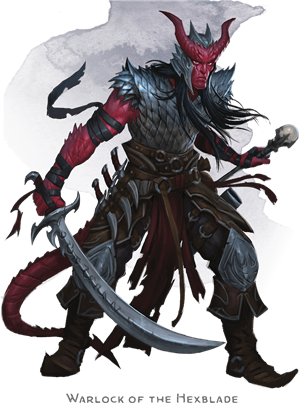 It’s not easy to be a Tank as a warlock. However, the powerful armor, mighty weapon, and fearsome curse of the Hexblade makes it possible for you to rise to the challenge.
It’s not easy to be a Tank as a warlock. However, the powerful armor, mighty weapon, and fearsome curse of the Hexblade makes it possible for you to rise to the challenge.
At 1st level, you learn two cantrips from the warlock spell list. You don’t get to change these, so choose wisely. Eldritch blast is a must-have for any warlock—even if you choose to fight in melee—but you should choose one other cantrip that synergizes well with your melee attacks. Booming blade punishes enemies for trying to escape your range, making it a prime choice.
Also at 1st level, you learn two 1st-level spells from the warlock spell list. The bonus damage from hexis quite potent, and afflicting an enemy with both hex and your Hexblade’s Curse is a devastating combo, though you can only impose one of those debuffs per turn, since both require your bonus action. Arms of Hadar is a disturbing and powerful spell that can both deal damage and impede your foes’ movement, making it harder for enemies to escape your reach and attack your allies.
At 2nd level, you learn a new 1st-level spell. Armor of Agathys is a strong choice, as it grants you increased survivability and additional damage; it also scales well with level. You also get to choose two Eldritch Invocations. Your most potent combat invocations come at later levels, so choose social invocations like Beguiling Influence and Mask of Many Faces for now.
At 3rd level, you gain the ability to learn 2nd-level spells from the warlock spell list. Also, all of your spell slots become 2nd-level spell slots. If a spell gains power from being cast in a higher-level slot, it will have a section at the end that says “At Higher Levels”. You learn one new spell, like enthrall or ray of enfeeblement.
You also gain a Pact Boon. Pact of the Blade is far and away the best choice for you, though you can still choose other options.
Since you can choose one of the invocations you know and replace it with another available invocation whenever you level up, you can gain access to boon-specific invocations at this level, you should exchange one of your current invocations for Improved Pact Weapon to instantly gain a +1 weapon. Also, your Hex Warrior bonuses now apply to any type of weapon you conjure using your Pact of the Blade boon; if you want to fight with a two-handed weapon, you can do that now!
At 4th level, you gain an Ability Score Increase, or a feat! If you want to improve your chances of dealing greater damage, you should put both points into Charisma. If you want a feat to help improve your damage output, consider the Lucky or War Caster feats. The Heavily Armored feat will also grant you proficiency with heavy armor, if you want to increase your Armor Class even further. If you’re content with medium armor, and have a high Dexterity score, the Medium Armor Master feat will make you stealthier and could improve your AC in medium armor.
Also at 4th level, you gain an additional spell. Consider taking a spell that has many uses in combat, like hold person, or a spell that you can combine with other effects, like darkness and the Devil’s Sight invocation. You also learn an additional cantrip from the warlock spell list. A non-combat focused cantrip will make you a more versatile adventurer, but lightning lure is a great tanking tool.
At 5th level, you gain the ability to learn 3rd-level spells from the warlock spell list. Also, all of your spell slots become 3rd-level spell slots. Fly grants you tremendous aerial control of the battlefield, and [spell]enemies abound/spell] can help you protect your party members by turning an enemy against its own allies.
Also at 5th level, you gain an additional Eldritch Invocation. Thirsting Blade is practically required, as it grants you an extra attack each turn. If you want to replace a previous invocation, Maddening Hex synergizes well with your Hexblade’s Curse, and Eldritch Smite pumps up your damage at the cost of your spell slots.
Support
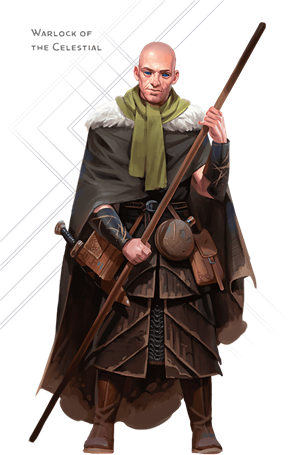 Few warlocks possess the proper attitude for the role of Support. Most are obsessed with increasing their own power at any cost, but those with a selfless heart can forge a pact with a Celestial. Such uncommon warlocks are granted miraculous healing and combat powers.
Few warlocks possess the proper attitude for the role of Support. Most are obsessed with increasing their own power at any cost, but those with a selfless heart can forge a pact with a Celestial. Such uncommon warlocks are granted miraculous healing and combat powers.
At 1st level, you learn two cantrips from the warlock spell list. You don’t get to change these, so choose wisely. Eldritch blast is a must-have for any warlock, even one in a support role. Magic stone is a funky cantrip that gives your allies access to magical damage at low levels, and prestidigitation is a fun cantrip to have on hand.
Also at 1st level, you learn two 1st-level spells from the warlock spell list. Charm person will give you the social utility befitting a kindly—or seemingly kindly?—warlock of the gods. Likewise, cause fear will allow you to speak with the voice of terrible angels, filling your foes with terror.
At 2nd level, you learn a new 1st-level spell. Protection from evil and good is circumstantial, but powerful in its niche. Note that it consumes holy water, which costs 25 gp. You also get to choose two Eldritch Invocations. Armor of Shadows is essentially permanent mage armor, and Eldritch Spear allows you to fight from incredible distance. Thief of Five Fates allows you to debuff your enemies in addition to buffing your allies.
At 3rd level, you gain the ability to learn 2nd-level spells from the warlock spell list. Also, all of your spell slots become 2nd-level spell slots. If a spell gains power from being cast in a higher-level slot, it will have a section at the end that says “At Higher Levels”. You learn one new spell, like hold person or mirror image.
You also gain a Pact Boon. Pact of the Blade is generally not your best choice if you want to lean into your Support role, but this boon can shine if you want to walk the fine line between Support and Offense. Pact of the Tome serves you well, as it grants you three cantrips from any spell list. Pact of the Chain grants you a powerful familiar, which you can use to help you explore dangerous areas, and even aid in combat! Pact of the Chain is likely the most useful to you, thanks to the Eldritch Invocations it unlocks.
Since you can choose one of the invocations you know and replace it with another available invocation whenever you level up, you can gain access to boon-specific invocations at this level, like Gift of the Ever-Living Ones, which makes your self-healing incredibly efficient.
At 4th level, you gain an Ability Score Increase, or a feat! If you want to improve your chances of affecting enemies with your spells, you should put both points into Charisma.
Also at 4th level, you gain an additional spell. Consider taking a spell that improves your stealth or maneuverability, like invisibility, or a debuff spell like ray of enfeeblement. You also learn an additional cantrip from the warlock spell list. A combat focused cantrip like thunderclap will make you a more versatile adventurer.
At 5th level, you gain the ability to learn 3rd-level spells from the warlock spell list. Also, all of your spell slots become 3rd-level spell slots. Thunder step can help you escape from unhappy combat situations, and magic circle can protect your entire party from powerful supernatural creatures.
Also at 5th level, you gain an additional Eldritch Invocation. Tomb of Levistus will help you survive in dire circumstances, and Armor of Shadows can help increase your survivability, if you’ve found it to be lacking so far.
Your Warlock, Your Rules
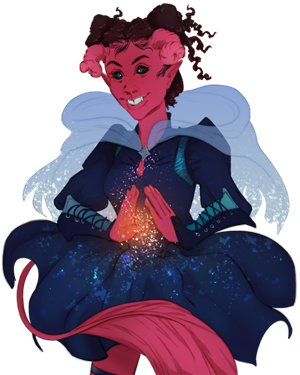 This was the longest Class 101 guide yet, and that speaks volumes about the versatility and dynamism of the warlock class. While warlocks have a reputation of being sinister, power-hunger characters, there is so much room to go beyond this classic archetype. Even this guide only skims the surface of mechanical and roleplaying options available to warlocks. Just take a look at the incredible diversity of characters we have in D&D shows right now. In Critical Role, Fjord is a former sailor who accidentally entered into a pact with mysterious idol known as Uk’otoa, and is reluctant to accept the being’s power, but eager to learn his patron’s secrets. In Acquisitions Incorporated: The “C” Team, K’thriss Drow’b is “a road, not a home” for the eldritch star being that grants him his power.
This was the longest Class 101 guide yet, and that speaks volumes about the versatility and dynamism of the warlock class. While warlocks have a reputation of being sinister, power-hunger characters, there is so much room to go beyond this classic archetype. Even this guide only skims the surface of mechanical and roleplaying options available to warlocks. Just take a look at the incredible diversity of characters we have in D&D shows right now. In Critical Role, Fjord is a former sailor who accidentally entered into a pact with mysterious idol known as Uk’otoa, and is reluctant to accept the being’s power, but eager to learn his patron’s secrets. In Acquisitions Incorporated: The “C” Team, K’thriss Drow’b is “a road, not a home” for the eldritch star being that grants him his power.
In my own D&D game, Worlds Apart, Astrid Sunglow (pictured, art by Cat Lu) is a celestial warlock whose energetic and cheerful attitude, heroic attitude, and flashy fighting style makes her more like Sailor Moon than a traditional blood-and-guts witch. That’s to say nothing of Worlds Apart’s main villain, Renault, a warlock-turned-lich who has put incredible strain upon his soul by forging pacts with all three Otherworldly Patrons from the Player’s Handbook, granting him incredible power at an incredible cost.
And that’s to say nothing of Farideh from Brimstone Angels, who has a will-they-won’t-they romantic relationship with her patron. Or the warlock I created for the narrative introduction of this article, who gains her power from the Undying spirit of her beloved, a powerful warlock in her own right who died before her.
All this to say, you can do just about anything with the warlock class, as long as you’re willing to learn the minutiae of its unconventional mechanics. I highly recommend giving it a try. Use this guide as a starting point, and then let your imagination run wild!
 James Haeck is the lead writer for D&D Beyond, the co-author of Waterdeep: Dragon Heist and the Critical Role Tal'Dorei Campaign Setting, the DM of Worlds Apart, and a freelance writer for Wizards of the Coast, the D&D Adventurers League, and Kobold Press. He lives in Seattle, Washington with his partner Hannah and their eldritch kittens Mei and Marzipan. You can usually find him wasting time on Twitter at @jamesjhaeck.
James Haeck is the lead writer for D&D Beyond, the co-author of Waterdeep: Dragon Heist and the Critical Role Tal'Dorei Campaign Setting, the DM of Worlds Apart, and a freelance writer for Wizards of the Coast, the D&D Adventurers League, and Kobold Press. He lives in Seattle, Washington with his partner Hannah and their eldritch kittens Mei and Marzipan. You can usually find him wasting time on Twitter at @jamesjhaeck.








-
View User Profile
-
Send Message
Posted Dec 17, 2018I really don't like how Eldritch Blast is basically required (you are right about that though!)
I homebrewed Invocations for all the other Cantrips so they are all viable options as well. If you want to use a different spell you can do the same
-
View User Profile
-
Send Message
Posted Dec 17, 2018Warlocks get 4d4 x 10 starting gold, so average is 100, not 50.
-
View User Profile
-
Send Message
Posted Dec 17, 2018Eldritch Blast should be a class ability rather than a cantrip. That would ensure everyone had it while freeing up a limited cantrip slot. It would also limit the common 2 level dip into warlock if it scaled with class level instead of character level.
-
View User Profile
-
Send Message
Posted Dec 17, 2018I am in love with the Hexblade. When I first found it on unearthed arcana I thought "I'm gonna make the darkest, most dramatic character I can think of." So far three of the characters I have ever played were Hexblades.
-
View User Profile
-
Send Message
Posted Dec 17, 2018I love the opportunities to roleplay when it comes to warlocks.
I just started a campaign last month, playing as a human warlock with a nobility background. She's a young woman trapped in a patriarchal political structure, being used as a bartering chip in marriage negotiations. She made a pact in order to escape being a political pawn.
To make things interesting, my DM and I cooked up an idea for a pact for her... it's that she has no idea what the pact is (and neither do I). The Archfey erased the details of the pact from her memory, so she has no idea what she will be giving up or will have to do in exchange for her powers. The DM has complete control over what the pact is and it's in his storytelling arsenal to bring it up whenever the time is right.
-
View User Profile
-
Send Message
Posted Dec 17, 2018YES, finally. I was wondering if they will make more Official Wsrlock classes. Also, Mike mearls, I LOVE your profile pic. Modrons are so cute
-
View User Profile
-
Send Message
Posted Dec 17, 2018Awesome. Now I'm ready for Warnock 102: The Next Semester.
-
View User Profile
-
Send Message
Posted Dec 17, 2018This isn't about warlocks but LET'S CELEBRATE!! THERE'S NOW A FULL SET OF D&D BEYOND CLASS GUIDES!!!!
Also, can you do guides for the UA classes (Mystic+Artificer)? They're not official but they seem really fun to play and thematically+functionally are just great.
-
View User Profile
-
Send Message
Posted Dec 17, 2018I'm afraid that I don't feel right doing a class guide on classes that are still in flux, like the Mystic and Artificer. The same goes for the Blood Hunter, which Matthew Mercer has told me is still in a state of design. That said, who knows what 2019 will bring? If we get new classes, I'll gladly do a 101 guide for them. If we don't, then perhaps you'll see a 201 advanced guide for the core 12 classes next year. :)
-
View User Profile
-
Send Message
Posted Dec 17, 2018I love the feel of Warlocks, and they're really good fun in both RP and combat. My one gripe is that the Archfey and Undying patrons seem quite underpowered in comparison with the others, especially the Fiend and the Hexblade. The Archfey seems to have an extremely narrow vision of what fey are and do, and if you're ever in a situation where you're dealing with a creature that can't be charmed or has truesight, half of your class abilities and spells become useless. The Undying feels underwhelming in terms of their additional spells and abilities, apart from the tenfold lifespan, which even I can't complain about. I love the aesthetic of the two patrons, but I can't help but feel I'd be getting a raw deal by making a pact with either of them while Fiend warlocks get to sling fireballs and knock monsters through other dimensions.
-
View User Profile
-
Send Message
Posted Dec 18, 2018I made some amazing warlocks my favorite is Hexblade. I just do SO much damage its just insane. At 4th level 12d6+34 I don't know about you but that is a lot for me.
My 2nd favorite is Newt Scamander, with not very much damage but with a lot of animal stuff and pact of the chain. He is also the archfey.
PS Newt also has a magic briefcase.
-
View User Profile
-
Send Message
Posted Dec 18, 2018I understand the perspective about warlocks lending themselves to baked-in roleplaying opportunities, but part of me kind of chafes whenever I encounter the sentiment. It feels like it takes away from all the other classes' conceptual space for similar circumstances.
Don't get me wrong -- I agree warlocks do indeed have fantastic flavor in this regard...but I believe all the other classes do too. Sorcerers have a special relationship to the magic in their world, clerics and druids certainly have powerful bonds to the supernatural entities and forces, fighters have visceral connections to people and politics of a setting, etc. All of these non-mechanical aspects of character class can have as much or as little impact on game play and stories as a warlock, which could be played for an entire campaign without really ever getting into any patron roleplaying situations.
I mention this not to be in contention with James' terrific guides, it's just something that comes to mind whenever I come across the sentiment. I hope players of all classes collaborate with their Dungeon Masters and fellow players to create and support each other's individual and collective stories!
-
View User Profile
-
Send Message
Posted Dec 18, 2018That's a really well-considered comment, and I get what you're saying. However, I think for players who are less experienced with roleplaying, as James says, Warlocks are more immediately accessible in that respect than other classes, because their relationship between their backstory and their play style is very explicitly linked at all levels. Bards, Druids, Paladins, Rangers and Wizards often have quite nebulous and unexplained attachments to their sources of power, and it's more work to expand on how they are relevant to the character now. And with the other classes, especially Fighters and Barbarians, there's a real risk of just ending up with 'Someone who is good at hitting stuff' and going no further (unless that's what you were going for deliberately).
I'd also say that from a mechanical perspective, RP opportunities and numbers of abilities basically correlate, because abilities require explanation: the mechanical complexity of a Warlock (or a Rogue for that matter) creates more things for a backstory and RP to explore straightaway, whereas an Evocation Wizard or a Champion Fighter, having comparably fewer different abilities, must either work harder to connect their mechanics to their character or rely on other parts of their character's makeup for roleplaying.
In my (admittedly limited) experience with Dungeons and Dragons, especially with other new players who were less creatively engaged with their character, Warlocks offer salient roleplaying opportunities almost immediately, because their relationship to a significant aspect of the world is already clear, and their abilities spring directly from that relationship. Most other classes (with probably the Sorcerer and the Cleric as exceptions) require deeper and more committed 'filling out' as characters either in-game or in character creation before they get the same opportunities. For example, in my first long-form campaign, the player who took over an NPC Rogue to join in later in the game only really started to flesh out the character beyond the broadest strokes when he unintentionally made contact with a Great Old One, and began the process of multiclassing into Warlock.
I'm not saying that Warlocks are some kind of shortcut to good roleplaying, because there is no such shortcut, but I think that, if a player is mechanically capable but less experienced in roleplaying and character building (which I think is the more likely combination than the other way around), a Warlock might be the best class to get them introduced to the concepts.
-
View User Profile
-
Send Message
Posted Dec 18, 2018I had a tiefling celestial warlock, with pact of the tome, by the time she was level 4 she could cast 9 cantrips
-
View User Profile
-
Send Message
Posted Dec 18, 2018I agree with both longshotist and ForceOfWyl. Warlocks truly do come with a kind of baked-in role-playing aspect by way of their patron, but longshotist has a point that this same quality is in other classes. Clerics and their deities, Paladins and their oaths and/or deities, Sorcerers and their bloodlines, as well as Druids and their circles all have the same baked-in opportunities to role-play based around their abilities.
In fact, some even help push that forward as the Warlocks do, like Clerics and Paladins.All three classes give you options to what kind of entity you draw your power from, whether that's from the perspective of a pact made with a patron or a set of beliefs centered upon the teachings of a god, or a secular cause of equal devotion. Each character made from those classes begins from the start with a relationship to something beyond and greater than themselves.
That said, ForceOfWyl isn't wrong either, regarding less experienced players seeing those classes not listed as requiring more personal input and easily becoming little more than a "I hit things" character. But I disagree that complexity lends itself to role-play, or that Warlock has the edge over all other classes. Clerics and Paladins have less complexity, but the exact same baked-in role-play capability.
Regardless of all that, this was a good article. Really glad to see these class guides finished, though sadly the Sorcerer guide took too long to be helpful. I had a brand new player to D&D who would have benefited, but I couldn't delay leveling. Not James' fault, just the way of it is.
Interested to see what takes the place of these. I'd certainly enjoy some more DM-centric articles, and maybe even a look back at some of the older published adventure modules.
-
View User Profile
-
Send Message
Posted Dec 18, 2018Woooo the class guides are all finally complete! I can say for myself that these guides have helped me start understanding other classes that didn't really interest me when I first started playing 5E. James thank you for taking the time to compile these wonderful guides and delve this far into the deeper details of all these classes.
-
View User Profile
-
Send Message
Posted Dec 18, 2018Are you going to revamp the Fighter one to include the Xanathar ones?
-
View User Profile
-
Send Message
Posted Dec 18, 2018whispers "Uk’otoa.."
-
View User Profile
-
Send Message
Posted Dec 18, 2018According to the novels, Farideh has slept with Lorcan several times.
-
View User Profile
-
Send Message
Posted Dec 18, 2018That's true-- if they're officialized (either in 6e whenever that comes out or in another supplement), I'll be happy to see their guides!
Thanks for the guides you've written though-- they've really helped me to understand D&D better and to learn to make interesting and powerful characters.